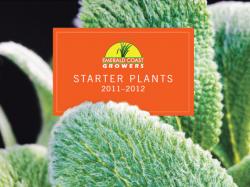Emerald Coast Growers Catalog Serves As Plant Trend & Demand Barometer
July 6, 2011 | 2 min to read

Pensacola, Fla. – When Emerald Coast Growers produces their annual catalog, they aren’t just filling the pages with attractive plant photos. They’re focused on giving their customers a guide to the latest plant trends and demand fluctuations.
“We analyze and assess both current and historical consumer preferences to determine where demand lies,” says Cheri Markowitz, Sales Manager. “Above all, we’re focused on providing the right plants at the right time—and ensuring our customers, in turn, deliver for their customers.”
The philosophy has made the annual book an essential tool for their grower and broker customers alike. This year’s version features hot new Sedum series from Terra Nova Nurseries, reflecting garden and home slant toward succulents. They’re also showcasing designer grasses—in this case the new niche of tender ornamentals for containers. And expanded stick-to-order and custom 128 programs reflect the current trend toward personalization and individualized service.
Of course, more than 130 new varieties speak for themselves. That includes maintaining their signature ornamental grass program and their own Native Wonders™ collection of North American native grasses and perennials, while significantly expanding their perennial plants line with a larger Hosta selection and more flowering plants like Alcea and Mandevilla.
The company ups the selling potential with picture tags for their perennials, specialty plants and the industry’s largest selection of ornamental grasses, and an available CD of customizable point-of-purchase cards that provide a simple and inexpensive way for retailers to market plants.
“The catalog goes hand in hand with our extensive online database, which is full of details including descriptions, zones, culture, usage and more,” says Cheri. “It’s fully searchable, and our site features a password-protected members-only side that’s designed to provide confidential pricing. Whether online, in print or in person, we’re focused on ease of doing business.”
For more information on Emerald Coast Growers’ 2011-12 Catalog or to order, call 877-804-7277 or visit www.ecgrowers.com.
Emerald Coast Growers is proud to celebrate 20 years of success in the horticulture business. Known for their wide variety of perennial starter plants and specialty plants, Emerald Coast Growers still maintains the distinction of being one of the industry's largest suppliers of ornamental grass liners to North American growers and retailers. With more than 400,000 sq. ft. of greenhouse space, 55 acres of farmland and growing locations in both the northeast and southeast, Emerald Coast Growers consistently supplies top quality starter plants to growers throughout North America. ECG starters are available by common carrier, grower truck, or customer pickup in Florida or Pennsylvania. For more information, please visit www.ecgrowers.com.
Source: Emerald Coast Growers
